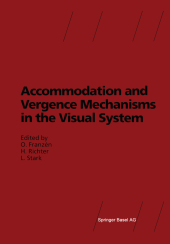 Neuerscheinungen 2013Stand: 2020-01-07 |
Schnellsuche
ISBN/Stichwort/Autor
|
Herderstraße 10
10625 Berlin
Tel.: 030 315 714 16
Fax 030 315 714 14
info@buchspektrum.de |

Ove Franzen, Hansn Richter, Lawrence Stark
(Beteiligte)
Accommodation and Vergence Mechanisms in the Visual System
Herausgegeben von Franzen, Ove; Richter, Hansn; Stark, Lawrence
2000. 2013. xix, 346 S. 100 SW-Abb.,. 244 mm
Verlag/Jahr: SPRINGER, BASEL; BIRKHÄUSER BASEL 2013
ISBN: 3-03-487588-6 (3034875886)
Neue ISBN: 978-3-03-487588-2 (9783034875882)
Preis und Lieferzeit: Bitte klicken
This conference was instigated by a combination of factors: The nature of the problem, the wide spread occupational epidemiology reported on eye symptoms and eye fatigue in the workplace, and the organizers´ awareness of the complexity of the scientific and clinical bases of knowledge that might be usefully applied. The introduction of new methods into system neurobiology provides new insights into how we receive and process information from the external world, and act upon it. New, non-invasive methods have opened the way to direct observation of the human brain in action. Due particularly to the interaction between the visual and oculomotor requirements involved, several clinical and scientific fields intersect when these issues are considered. To provide clear vision the accommodative and pupillary mechanisms are used. To maintain binocularity, the ver gence oculomotor system, sensitive to fatigue, must attain congruence with accommodative levels. This accommodation-vergence linkage was a focus of our symposium.
Contents.-Preface.- Acknowledgements.- Scientific Committee.- Opening address by the University Chancellor Stig Hagström.- Participants of the International Symposium at the Wenner-Gren Center, Stockhom.- List of contributors.- Part I: CNS pathways, single unit, neural population and structural correlates of the accommodative system.- Mays, L. E. and Gamlin, P. D. R.: Neuronal circuits for accommodation and vergence in the primate. Gnadt, J. W.: Neural codes for three-dimensional space. Ohtsuka, K. and Sato, A.: Neuronal connectivity between the accommodative and active fixation systems. Erichsen, J. T., Hodos, W. and Evinger, C.: The pupillary light reflex, accommodation and convergence: comparative consideration. Bando, T., Hara, N., Takagi, M., Hasebe, H. and Toda, H.: Vergence eye movement and lens accommodation: cortical processing and neuronal pathway. Takeda, T., Endo, H. and Hashimoto, K.: Research on dynamic accommodation using TDO III (Three Dimensional Optometer III) and MEG (Magnetoencephalography). Richter, H., Lee, J. T. and Pardo, J. V.: Neuroanatomical correlates of the near response: Voluntary modulation of accommodation in the human visual system. Pardo, J. V., Sponheim, S. R., Costello, P., Lee, J. T., Han, Y. and Richter, H.: Functional neuroanatomy of the human near/far response of the visual system to blur cues: Fixation to point targets at different viewing distances. Franzén, O., Lennerstrand, G., Pardo, J. and Richter, H.: Spatial contrast sensitivity and visual accommodation studied with VEP (Visual Evoked Potential), PET (Positron Emission Tomography) and psychophysical techniques.- Part II: Autonomic nervous system, microfluctuations and resting state of accommodation.- Charman, W. N.: Accommodation and the through-focus changes of the retinal image. Winn, B.: Accommodative microfluctuations: a mechanism for steady-state control of accommodation. Gilmartin, B.: Pharmacology ofaccommod


